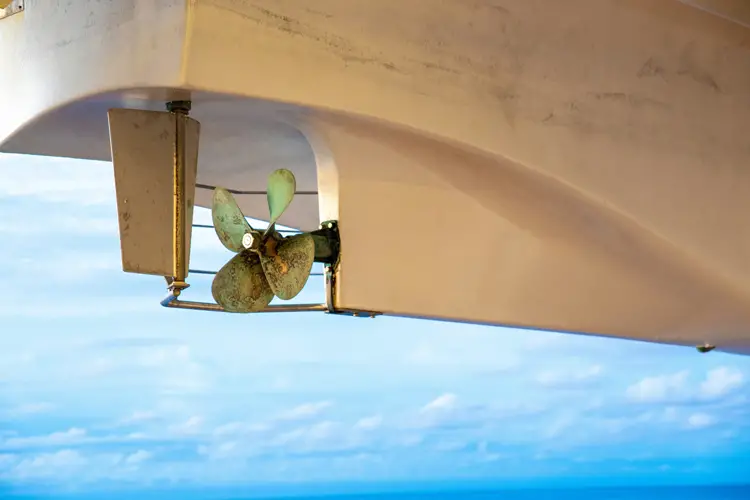Skeg Guards: Are They Actually Worth It?

Almost every boat owner has heard of a Skeg guard and has participated in at least one debate on whether they are actually a good investment. Skeg guards are usually metal, plastic, or fabric covers that are designed to protect the skeg of your boat from damage and general wear and tear.
In this article, we will explore whether skeg guards are actually worth your time, the benefits of installing a skeg guard, along with the drawbacks.
What is a Skeg Guard?
A skeg guard is considered an extremely important piece of equipment for most ships. This is because the skeg guard protects the skeg (skeg refers to the part of the ship that connects the keel with the bottom of the rudder post) of the ship from external damage.
The skeg plays an important function in the boat as it stabilizes and changes the direction of the ship. Usually, a skeg guard is a plastic or metal cover that is fitted on the skeg with screws and bolts in order to prevent damage from debris in the water. It also reduces the risk of barnacle formation on the skeg.
Why is Skeg Guard Used?
The skeg plays a vital role in the boat as it protects the propeller and rudder of the ship from underwater obstruction, makes the boat directionally stable, and helps control the direction of the boat. Damage caused to the skeg from underwater debris leads to a reduction in directional stability, ineffective steering, and excessive vibration of the engine. Skeg guards can effectively protect the skeg from such damage and in some cases even protect the skeg from water damage.
Benefits of Skeg Guards
There are several benefits of skeg guards. These are:
- Protects from damage- Skegs play an extremely important role in the navigation and stability of a boat. Therefore, any harm caused to the skeg can adversely affect our ability to properly steer the ship in the right direction. A good skeg guard will effectively protect the skeg of your boat from rocks and other river debris.
- Improves tracking and stability- Protection provided by the skeg guards improves the boat’s overall performance and tracking as the skeg guards deflect harmful debris from the ship. By covering your boat’s keel and skeg with a skeg guard, you are creating a barrier between the water and the boat which makes the boat more stable, especially in rough weather conditions.
- Reduces drag and enhances the boat’s performance- The barrier provided by the skeg guard between the boat and the water reduces the drag on a board by breaking the surface tension of the water. This enhancement in the performance of the boat helps the boat move easily through the water, thereby increasing the average speed of the boat and saving fuel.
- Saves money on expensive repairs- A well-installed Skeg will save you a pretty penny on expensive repairs, especially while your boat is operating at heavy speeds frequently.
Drawbacks of Using Skeg Guards
While the drawbacks of using skeg guards are outweighed by the advantages significantly, we will still take a look at them. First of all, a good skeg guard can be expensive and they are typically a waste of money if you are not taking your boat in shallow waters frequently.
Next, installation of skeg guards is usually complicated, and poor installation can cause more damage to the boat than prevent damage. It is also important to know that skeg guards, especially the metal ones, add weight to the boat. Damage to an aluminum skeg can be heavy on your pockets and the skeg guard’s inability to protect the propeller of the boat will only add to the cost.
Are Skeg Guards for your Boats?
It is only human to wonder whether a skeg guard is actually worth it for your boat, especially if you have no prior experience with boats. The answer is pretty simple- ‘It all depends on your boat and how you use it.’
The people you hear who swear by using skeg guards are almost always using their boats in a water body with shallow water, rocks, and stumps. In this case, a skeg guard is absolutely necessary because it will certainly protect your skeg and propeller from damage. However, if you use your boat for recreational purposes in waters with not a lot of obstacles, then installing a skeg guard is not worth it.
Types of Skeg Guards
There are usually three common types of skeg guards. These are the skeg guards made from rubber or plastic, metal, and fabric. The rubber or plastic skeg guards are commonly used because they are inexpensive and easier to install than the metal and fabric skeg guards. However, the plastic skeg guards and fabric skeg guards do not protect the skeg from debris like rocks and other sharp objects, as conveniently as the metal ones.
Difference between Skegs and Rudders
To a novice, the difference between a skeg and a rudder might seem similar in appearance but to an experienced person, there are a few things that set them apart. For instance, rudders tend to be longer and narrower than a skeg. Unlike a rudder which shifts while the boat is moving, a skeg won’t move at all because it is an extension of the keel.






